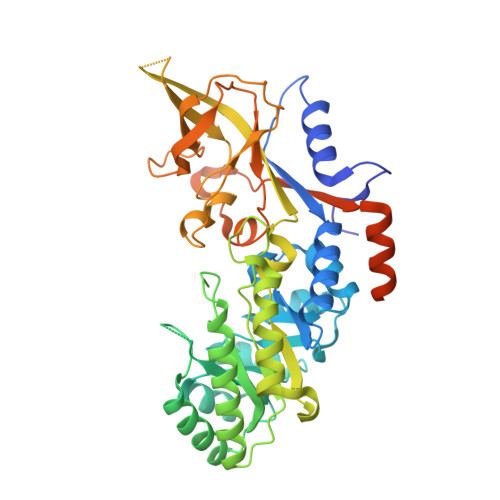A structural insight into the inhibition of human and Leishmania donovani ornithine decarboxylases by 1-amino-oxy-3-aminopropane.
Dufe, V.T., Ingner, D., Heby, O., Khomutov, A.R., Persson, L., Al-Karadaghi, S.(2007) Biochem J 405: 261-268
- PubMed: 17407445
- DOI: https://doi.org/10.1042/BJ20070188
- Primary Citation of Related Structures:
2ON3, 2OO0 - PubMed Abstract:
The critical role of polyamines in key processes such as cell growth, differentiation and macromolecular synthesis makes the enzymes involved in their synthesis potential targets in the treatment of certain types of cancer and parasitic diseases. Here we present a study on the inhibition of human and Leishmania donovani ODC (ornithine decarboxylase), the first committed enzyme in the polyamine biosynthesis pathway, by APA (1-amino-oxy-3-aminopropane). The present study shows APA to be a potent inhibitor of both human and L. donovani ODC with a K(i) value of around 1.0 nM. We also show that L. donovani ODC binds the substrate, the co-enzyme pyridoxal 5'-phosphate and the irreversible inhibitor alpha-difluoromethylornithine (a curative agent of West African sleeping sickness) with less affinity than human ODC. We have also determined the three-dimensional structure of human ODC in complex with APA, which revealed the mode of the inhibitor binding to the enzyme. In contrast with earlier reports, the structure showed no indication of oxime formation between APA and PLP (pyridoxal 5'-phosphate). Homology modelling suggests a similar mode of binding of APA to L. donovani ODC. A comparison of the ODC-APA-PLP structure with earlier ODC structures also shows that the protease-sensitive loop (residues 158-168) undergoes a large conformational change and covers the active site of the protein. The understanding of the structural mode of APA binding may constitute the basis for the development of more specific inhibitors of L. donovani ODC.
Organizational Affiliation:
Department of Molecular Biophysics, Lund University, S-221 00 Lund, Sweden.















